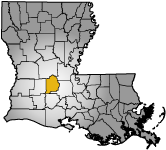SECTION: 607 PRISONER TRANSPORT
SECTION: 607
TITLE: PRISONER TRANSPORT
EFFECTIVE DATE: February 15, 2017
PURPOSE
This policy establishes procedures for transporting persons who have been taken into custody.
POLICY
It shall be the policy of the Department that all prisoners shall be transported as soon as practical after the arrest, to the Evangeline Parish Sheriff's Department with the exception of those requiring medical attention.
It shall be the policy of the Department to transport arrested persons in a manner that will provide for the security and safety of the prisoner, transporting deputy(s) and the public.
This policy shall not apply to the transportation unit as their standards will be set via standard operating procedure (SOP).
PROCEDURES
- When applicable, all prisoners shall be transported in a unit which has a secured cage. Prisoners may be transported in units with no cage, but will be at the discretion of the supervisor on duty. Prisoners shall be seat belted.
- The transporting deputy shall always search a prisoner before placing him into the vehicle. Deputies should never assume that a prisoner does not have possession of a weapon or contraband or that someone else has already searched the prisoner. The transporting deputy shall conduct a search of the prisoner each time the prisoner enters custody of the deputy.
- Transporting deputies shall search the rear seat area of their unit before each prisoner transport, to ensure that no weapons or contraband are available to the prisoner. Further, after delivering the prisoner, deputies shall again search their unit to ensure that the prisoner did not hide contraband or other evidence.
- Positioning of prisoners in the transport vehicle shall be:
- Single deputy transporting a single prisoner shall place the prisoner in the rear opposite of the deputy.
- When investigators are transporting suspect(s) / prisoner(s), two (2) investigators shall be utilized to transport said person(s). The suspect / prisoner shall be placed in the front passenger side of the vehicle. The second investigator shall be seated directly behind the
suspect / prisoner as a means of observance or defense.
- All persons placed under arrest, shall be properly handcuffed prior to their being transported in any Department vehicle.
Control of prisoners while transporting:
- While transporting a prisoner, the deputy shall maintain visual contact at all times, even when it becomes necessary to allow the prisoner the use of a toilet.
- Prisoners shall never be left unguarded or unattended.
- In the situation where a male deputy transports a female prisoner or vice versa, the beginning mileage of the transport and the ending mile of transport shall be given. In the case a prisoner of the opposite sex needs to use the restroom, we shall utilize a deputy / representative of the same sex as the prisoner. If there is no one available, the deputy shall ensure that there are no escape routes or weapons available to the prisoner, prior to being allowed to use the facility.
- Deputies shall not involve himself in any other activity when transporting a prisoner with the exception of an officer down call.
- Under no circumstances shall a deputy transporting a prisoner engage in a pursuit.
In the event a prisoner escapes while being transported, the transporting deputy will use the following procedures:
- The transporting deputy will notify the dispatcher and the shift supervisor of the escape.
- If the escape occurs outside the jurisdictional boundaries of the parish, request for assistance will be made to that agency.
- The transporting deputy shall pursue the escapee only if it does not require leaving a second prisoner unattended. Pursuing deputies shall not use more force than is necessary in apprehending an escapee and shall adhere to all Departmental policies.
If a prisoner is transported to a medical facility and is admitted by the attending physician, the deputy will immediately notify his supervisor. The supervisor will use the following procedures
to ensure control of the prisoner:
- A request shall be made to put the prisoner in a secured private room.
- The prisoner shall be kept under observation at all times, and if possible, restraining devices used. Medical personnel shall be consulted concerning the use of restraining devices.
- The Sheriff shall be notified as soon as possible.
- A schedule shall be completed by the Division Commander for guarding of the prisoner. Booking procedures shall be conducted, in order to allow for arrangements to be made for arraignments.
- Prisoners will not be denied access to their attorney; however, the attorney must show proper identification and submit to a search of his person and belongings. The search shall be for the purpose of security and shall in no way be utilized as a pretext to read or examine confidential documents.
- Should the attorney refuse to comply with the security procedure, the deputy will deny the attorney access to the prisoner and the immediate supervisor shall be notified. The supervisor shall respond to the location and shall assist in bringing the situation to a successful resolution.
- The supervisor shall brief every deputy who is assigned to guard a prisoner.
- The supervisor will ensure that guards are checked periodically and relieved as necessary.
Restraining Devices:
The following procedures shall be followed for restraining prisoners during transportation:
- All prisoners shall be handcuffed with both hands behind their back.
- Shackles may be utilized when necessary, to avoid a prisoner escaping or to stop the resistance of a prisoner from causing damage to a department vehicle or injury to a deputy.
- Under no circumstances will a prisoner be handcuffed to a part of the transport vehicle, such as the door post, protective screen barrier, etc.
In regards to: All Rules, Regulations, Policy & Procedures and Special Orders are at the discretion of the Sheriff based on departmental need and the severity of the infraction.



